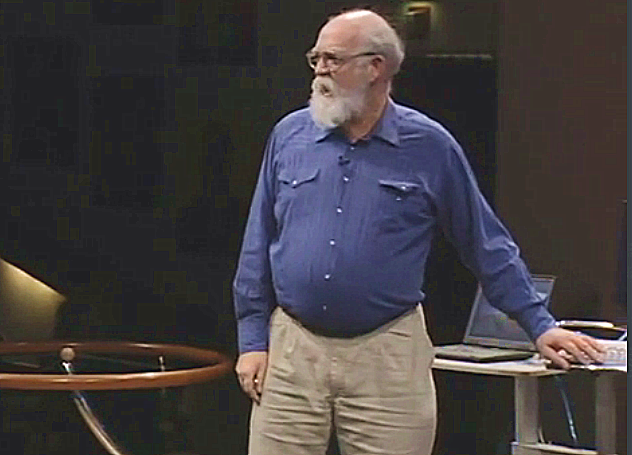But now, notice there are two ways of seeing the cube, right?
现在,你注意到了有两种方法来看那个立方体,对吧?
It's a Necker cube.
这是一个内科尔方块。
Everybody can see the two ways of seeing the cube? OK.
大家都可以看出两种看方块的方法吧?好的
Can you see the four ways of seeing the cube?
那你们能看出四种方法来吗?
Because there's another way of seeing it.
由于有不同的方法来看它。
If you're seeing it as a cube floating in front of some circles,
如果你让方块浮在圆圈之上,
some black circles, there's another way of seeing it.
那些黑色的圆圈,就有另一种看的方法。
As a cube, on a black background, as seen through a piece of Swiss cheese.
如果把方块当作放在黑色背景之上,就像是从一块瑞士奶酪的洞里看过去。
Can you get it? How many of you can't get it? That'll help.
你们能理解吗?多少人不能理解?这样应该有所帮助。
Now you can get it. These are two very different phenomena.
现在你们明白了。这里有两个很不一样的现象。
When you see the cube one way, behind the screen, those boundaries go away.
如果你把方块当作是放在屏幕之后的,边界就没了。

But there's still a sort of filling in, as we can tell if we look at this.
不过仍然可以把它填充出来,如果你用这种方法去看。
We don't have any trouble seeing the cube, but where does the color change?
我们可以毫无障碍的看到方块,但是颜色是在哪里改变的呢?
Does your brain have to send little painters in there?
你的大脑在那儿放了小画家?
The purple-painters and the green-painters fight over who's going to paint that bit behind the curtain? No.
画紫色的画家和画绿色的画家,两者争着要在遮挡物之后涂色吗?不是。
Your brain just lets it go. The brain doesn't need to fill that in.
你的大脑就由它去了。大脑不需要填充它。
When I first started talking about the Bradley, Petrie, Dumais example that you just saw
当我第一次谈论到你刚刚看到的 Bradley, Petrie, Dumais的例子
I'll go back to it, this one I said that there was no filling-in behind there.
让我退回到它,这个。我说过在被挡住的地方是没有填充颜色的。
And I supposed that that was just a flat truth, always true.
我以为这是一个公理,总是对的。
But Rob Van Lier has recently shown that it isn't.
不过 Rob Van Lier最近证明了它不是。
Now, if you think you see some pale yellow -- I'll run this a few more times.
现在,如果你觉得你看到了一些黄色--让我再做几次。
Look in the gray areas, and see if you seem to see something sort of shadowy moving in there
看这些灰色区域,你是不是好像看到有些阴影在移动
yeah, it's amazing. There's nothing there. It's no trick.
是的!那很神奇。那里没有东西。没耍花招。
This is Ron Rensink's work,
这是 Ron Rensink的作品,
which was in some degree inspired by that suggestion right at the end of the book.
在一定程度上,被书最后的暗示所激发。
Let me just pause this for a second if I can. This is change-blindness.
让我暂停几秒。这是盲变化。
What you're going to see is two pictures, one of which is slightly different from the other.
你会看到两幅图片,一幅与另一幅有些许区别。
You see here the red roof and the gray roof, and in between them there will be a mask,
你看这里是红色屋顶而那里是灰色,他们之间有个遮罩,
which is just a blank screen, for about a quarter of a second.
这里只是一个空白屏幕,在大概0.25秒。
So you'll see the first picture, then a mask, then the second picture, then a mask.
所以你将看到第一幅图,然后是遮罩。再然后是第二幅图,然后是遮罩。
And this will just continue, and your job as the subject is to press the button when you see the change.
然后这会重复,你作为实验对象的工作就是当你看到变化的时候按下按钮。
So, show the original picture for 240 milliseconds. Blank.
所以是,原始图片出现240毫秒。空白。
Show the next picture for 240 milliseconds. Blank.
下一幅图片出现240毫秒。空白。
And keep going, until the subject presses the button, saying, "I see the change."
这会一直持续,直到实验对象按下按钮,表示“我看到变化了。”
So now we're going to be subjects in the experiment.
好,现在我们就是实验对象。
We're going to start easy. Some examples.
我们从简单的开始。一个例子。












